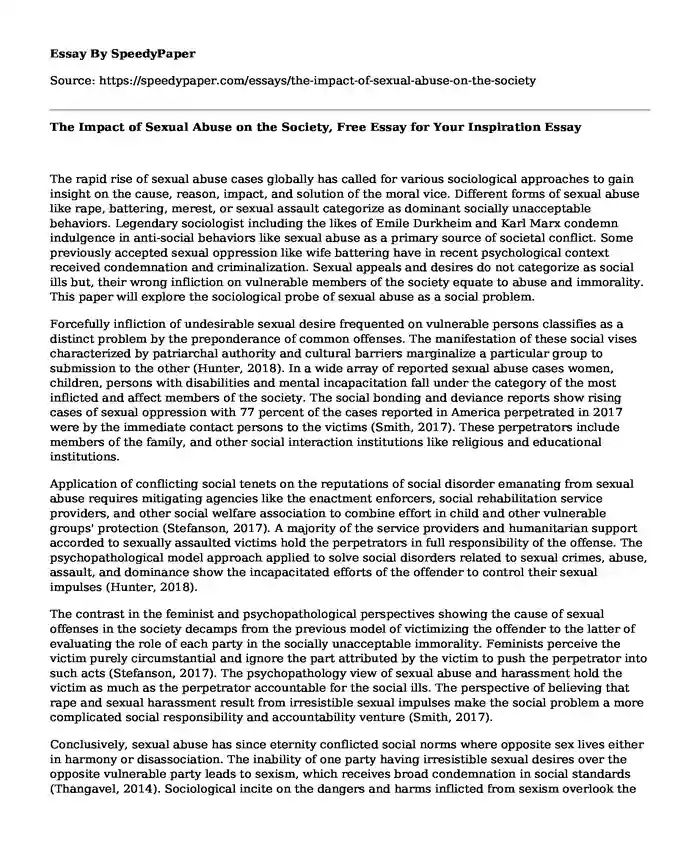
| Type of paper: | Essay |
| Categories: | Sexual abuse |
| Pages: | 3 |
| Wordcount: | 665 words |
The rapid rise of sexual abuse cases globally has called for various sociological approaches to gain insight on the cause, reason, impact, and solution of the moral vice. Different forms of sexual abuse like rape, battering, merest, or sexual assault categorize as dominant socially unacceptable behaviors. Legendary sociologist including the likes of Emile Durkheim and Karl Marx condemn indulgence in anti-social behaviors like sexual abuse as a primary source of societal conflict. Some previously accepted sexual oppression like wife battering have in recent psychological context received condemnation and criminalization. Sexual appeals and desires do not categorize as social ills but, their wrong infliction on vulnerable members of the society equate to abuse and immorality. This paper will explore the sociological probe of sexual abuse as a social problem.
Forcefully infliction of undesirable sexual desire frequented on vulnerable persons classifies as a distinct problem by the preponderance of common offenses. The manifestation of these social vises characterized by patriarchal authority and cultural barriers marginalize a particular group to submission to the other (Hunter, 2018). In a wide array of reported sexual abuse cases women, children, persons with disabilities and mental incapacitation fall under the category of the most inflicted and affect members of the society. The social bonding and deviance reports show rising cases of sexual oppression with 77 percent of the cases reported in America perpetrated in 2017 were by the immediate contact persons to the victims (Smith, 2017). These perpetrators include members of the family, and other social interaction institutions like religious and educational institutions.
Application of conflicting social tenets on the reputations of social disorder emanating from sexual abuse requires mitigating agencies like the enactment enforcers, social rehabilitation service providers, and other social welfare association to combine effort in child and other vulnerable groups' protection (Stefanson, 2017). A majority of the service providers and humanitarian support accorded to sexually assaulted victims hold the perpetrators in full responsibility of the offense. The psychopathological model approach applied to solve social disorders related to sexual crimes, abuse, assault, and dominance show the incapacitated efforts of the offender to control their sexual impulses (Hunter, 2018).
The contrast in the feminist and psychopathological perspectives showing the cause of sexual offenses in the society decamps from the previous model of victimizing the offender to the latter of evaluating the role of each party in the socially unacceptable immorality. Feminists perceive the victim purely circumstantial and ignore the part attributed by the victim to push the perpetrator into such acts (Stefanson, 2017). The psychopathology view of sexual abuse and harassment hold the victim as much as the perpetrator accountable for the social ills. The perspective of believing that rape and sexual harassment result from irresistible sexual impulses make the social problem a more complicated social responsibility and accountability venture (Smith, 2017).
Conclusively, sexual abuse has since eternity conflicted social norms where opposite sex lives either in harmony or disassociation. The inability of one party having irresistible sexual desires over the opposite vulnerable party leads to sexism, which receives broad condemnation in social standards (Thangavel, 2014). Sociological incite on the dangers and harms inflicted from sexism overlook the impacts on the victim ignoring the damage suffered by the perpetrator. Social behavior influenced by conflict and cohesion draws the subordination and superordination of the groups of social settings where oppression exists. The application of sociological principles to understand the extent and effects of sexual abuse in the capacity of social definition of common challenges shows the lack of harmony in the institutions of social acceptance.
References
Hunter, K. (2018). Sexual assault is a social problem. Opinion Columist, Ocolly News, Jan 28, 2014, Col, 2.
Smith, L. (2017). Child Sexual abuse and good practice for social workers. IRISS, 16th Nov 2017.
Stefanson, K (2017) Chapter 2: Staging a Caring Atmosphere: Child-Friendliness in Barnahus as a Multidimensional Phenomenon. In S Johansson et al. (Eds.), Collaborating Against Child Abuse: Exploring the Nordic Barnahus Model, pp.35-57. Cham: Palgrave Macmillan.
Thangavel, G. (2014). Social issues- Sexual abuse, Doordarshan National News & Politics, Feb 26, 2014. Retrieved on 1st Mar, 2018 from www.slideshare.net/gayathrivathiriyar/Social-Issue-Sexual-Abuse
Cite this page
The Impact of Sexual Abuse on the Society, Free Essay for Your Inspiration. (2022, Mar 30). Retrieved from https://speedypaper.net/essays/the-impact-of-sexual-abuse-on-the-society
Request Removal
If you are the original author of this essay and no longer wish to have it published on the SpeedyPaper website, please click below to request its removal:
- Dynamics of Abortion, Free Essay for Students
- Paper Sample for Free: Diet and Fitness about Breast Cancer
- Free Essay Example: Managerial Leadership Style
- Free Essay Example. Synopsis of Audiotopia
- Report on Applications of Decision Models
- Difference Between Substance Use, Abuse, and Addiction - Paper Example
- Unveiling the Opioid Crisis: Effects on Youth, Health, and Public Intervention in Flint, Michigan - Essay Sample
Popular categories




